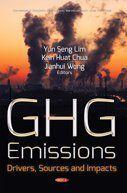
The study deals with decomposition-based analysis of greenhouse gas (GHG) emissions in European Union (EU) Member States (MS). The policies shaping the trends in GHG emissions across the EU MS are analysed. The decomposition of GHG emissions is performed based on the Kaya identity approach. The Kaya identity is defined as an equation relating factors of the economic activity to the level of human impact on the climate change, as represented by the emissions of the greenhouse gas. In particular, carbon dioxide emission is the main component of the emission. Therefore, the Kaya identity stipulates that total emission level can be expressed as the product of four factors: human population, gross domestic product (GDP) per capita, energy intensity (per unit of GDP), and carbon intensity (emissions per unit of energy consumed).
The decomposition-based analysis of GHG emission trends in EU MS was performed to quantify the main drivers of GHG emission reduction in the EU MS. Indeed, the EU MS conformed to achieve the targets regarding GHG emission reduction, renewable energy sources (RES) in the final energy consumption, and energy intensity reduction (compared to year 2005 level) in 2020 and 2030. As all these targets are interrelated and have to be achieved simultaneously, it is very important to track the changes of GHG emissions in EU Member States with regards to their commitments towards GHG emission reduction, changes in energy intensity, and increase in the share of renewables in the final energy consumption. The Kaya identity and index decomposition analysis allow linking the changes in GHG emissions to the changes in energy intensity and carbon intensity of energy which directly captures the increase of the share of renewables in the final energy consumption. Therefore, the use of the Kaya identity and index decomposition analysis allows quanitfying the impact of increase in the use of renewables and decreasing in energy intensity on GHG emission change in the EU MS. Also, we take agricultural sector as a case study. Agricultural sector is tightly related to food security goals and, therefore, remains an important economic activity within an economy in spite of the stage of the economic development. Thus, the drivers of the GHG emission in agriculture are analysed. Indeed, the increasing considerations of the climate change require modelling and mitigating environmental pressures generated by agricultural and other sectors. Therefore, we focus on energy-economy-climate nexus in agriculture by analysing the dynamics in carbon dioxide emission, energy use, and economic activity in this study. The data from 2005 to 2014 for decomposition analysis were collected from Eurostat database. The research relies on the index decomposition analysis and data envelopement analysis.
Štreimikienė, D.; Baležentis, T. 2017. Decomposition of GHG Emission in the European Union, In GHG Emission / Drivers, Sources and Impacts / Series: Renewable Energy: Research, Development and Policies. New York: NOVA Science Publishers, 2017 p. 1-158. ISBN 978-1-53612-191-9.
Copyright © 2017 by NOVA Science Publishers, Inc.
